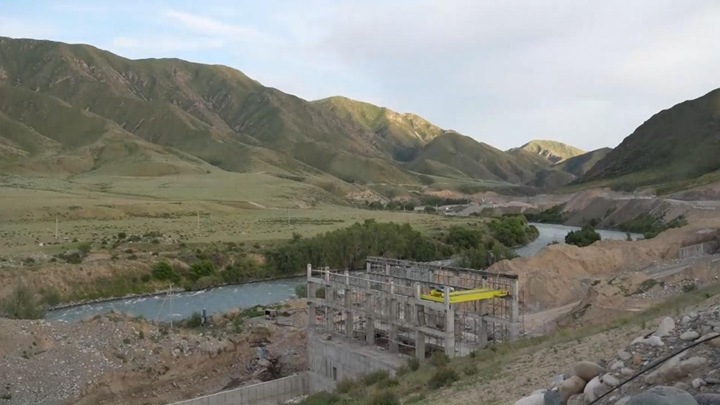The HPP on the Koksu river: officials and the developer are confused in the answers
At the end of September, archaeology activists held a press conference at which they once again expressed concerns about the threat to historical monuments from hydroelectric power stations being built on the Koksu River. After the press conference, the Orda edition.kz has written to officials and asked for comments on this. The correspondent of the publication tells about what answers came.:

The company EnergoBildsErvice, the developer of the Mine HPP—1 and HPP-2, was the first to respond to the article about Coke power plants without waiting for a request. The letter says that the project of the stations has passed an eco-examination and in general:
“The project is implemented according to the derivational principle — without dams and reservoirs; the technology of small hydroelectric power plants, minimizing the impact on the environment; does not change the riverbed and does not affect the climate of the region.”
There are still questions on at least two points here. The first is the absence of dams and reservoirs. During a meeting with social activists in January 2025, the project manager of the Mine hydroelectric power stations, Aliy Karabalin, also claimed that there would be no dam, but there would be a hydroelectric power plant. But at the same time, to all those gathered, including the Orda journalist. kz, he personally demonstrated a section of the Koksu riverbed, which is planned to be flooded. We dare to assume that in technical terms the flooded area is not called a reservoir. However, the fact remains that part of the Koksu Gorge will be flooded during the construction of the Rudnichnaya HPP-1.
In principle, there has never been any talk about changing the riverbed. But again, at the January meeting with the public, Karabalin explained that a significant part of the water from the Coke plant would go into the bypass channel, through which it would be discharged from the Rudnichnaya HPP-1 to the turbines of the Rudnichnaya HPP-2. At the same time, at the end of April, water rose sharply on the Coke, which, among other things, affected the canal under construction.
Regarding the archaeological examination, EnergoBildsErvice continues to insist that it was not mandatory for the Mining HPPs, but they agreed to conduct it.
“We, as a Kazakhstani company, aware of our responsibility for the preservation of cultural heritage, including the Eshkiolmes petroglyphs located 50 km from the construction of the Mining HPPs, decided to hold it jointly with the A. H. Margulan Institute of Archaeology. This issue is of fundamental importance to us. Therefore, we not only initiated the examination, but also continue to provide archaeologists with full assistance,” the company’s response says.
At the same time, EnergoBildsErvice did not respond to the information that ancient burial grounds were destroyed during the construction of the hydroelectric power station even before the start of the examination.
Now about what the authorities answered us.
We asked quite a lot of questions to the Ministry of Energy and the Zhetys Akimat, but in the end we got answers to only some of them.
First, we asked how many power plants are planned to be built on the river. Because the numbers sounded then seven, then 10. Secondly, we asked when they are planned to be built.
The Ministry of Energy still answered — there will be seven hydroelectric power stations. And just like the Rivers Without Boundaries Foundation, they indicated that all seven stations are planned to be commissioned in 2029. Namely:
- Two Verkhne-Talapta HPPs with a capacity of 4.8 and 12.8 MW will be installed in December 2029.
- Rudnichnye HPP-1 and HPP-2 with a capacity of 42 MW (they are considered to be one object) — in October 2029.
- Eskeldinskaya HPP with a capacity of 37.3 MW — in October 2029.
- Three more unnamed hydropower plants with a capacity of 10.5 MW, 39.99 MW and 53 MW will also be in October 2029.
But where they will be located and for how many of them reservoirs and counter-regulators are provided, the Ministry of Energy did not answer. One of the claims of public figures to the authorities is also that all these months they have not been able to reach specific sites for the construction of power plants.
The akimat of Zhetysu wrote that there will be only two hydroelectric power stations in general.
“It is planned to implement two projects on the Koksu River totaling 29.2 billion tenge with the creation of 65 jobs: Bekzat LLP — construction of a hydroelectric power station on the Koksu River (2029) and Energobildservice LLP — construction of Mine HPPs-1 and HPPS-2,” the regional administration said in response.
They either don’t know about the construction of five more there, or something else. By the way, the akimat of the Zhetysu region continues to persistently mention Bekzat LLP, which in fact was liquidated back in November 2022. And as I wrote earlier Orda.kz , its legal successor was Verkhne-Talaptinskaya HPP LLP.
Separately, we asked about the Verkhne-Talaptinskaya HPP. During the press conference, public figures said that the archaeological examination was carried out in a small area. The Ministry of Energy stated that Kazarchaeology LLP conducted an archaeological examination on an area of 50 hectares in 2022. But about the area of the environmental assessment, the Ministry of Energy did not specify, simply indicating that it was conducted in January 2022.
In the akimat of the region, in response to our question about the Verkhne-Talaptinskaya HPP, they simply copied the text of their own press release dated June 20, 2025.
The confrontation over the construction of a cascade of hydroelectric power stations on the Koksu River in the Zhetysu region began several months ago. Public activists believe that their construction can cause harm in several directions at once. This includes ecology, and archaeological sites, many of which are scattered on the banks of the Koksu, and tourism, and even agriculture. Representatives of the authorities and developers insist that there will be no harm from power plants either for historical heritage or for the environment.
Igor Ulitin (Orda.kz )
Original (in Russian): ГЭС на реке Коксу: чиновники и застройщик путаются в ответах


